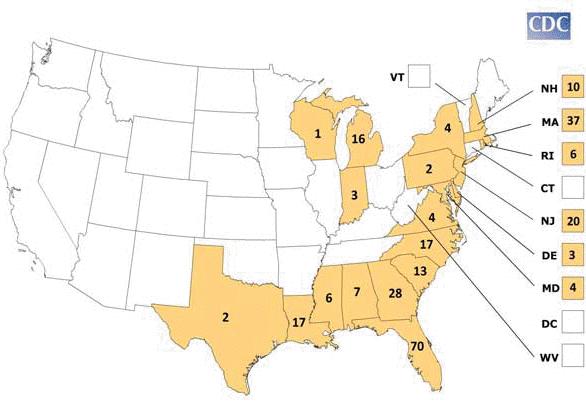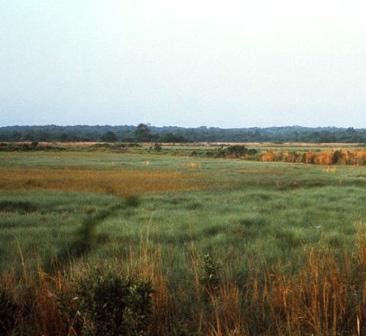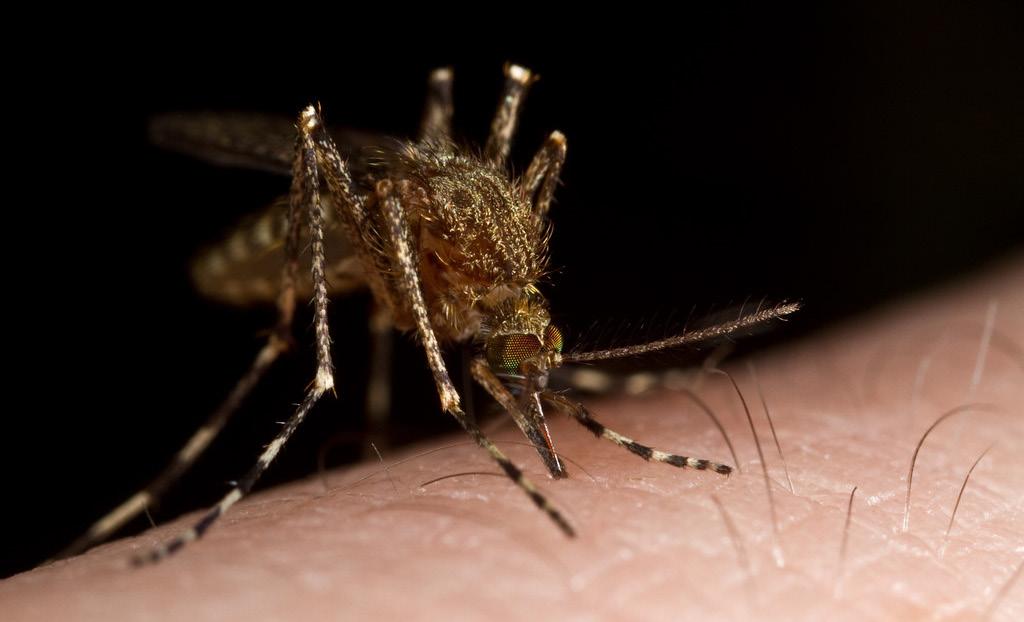
10 minute read
E.E.E. OUTBREAKS
E.E.E. Outbreaks How Climate Change May Be Fueling Them
By Vanessa Blas
Advertisement
Between August and October 2019, the Center for Disease Control received word of over thirty cases of patients infected with the eastern encephalitis virus, including twelve deaths, confirming a series of unprecedented outbreaks occurring in the United States. 1 Three of those deaths occurred in Connecticut. A press release by Connecticut Governor Ned Lamont urged residents to be cautious while outdoors and avoid getting bitten by mosquitoes, the transmitter of the virus. 2 With five of the other fatalities occur

ring in Michigan, three in Massachusetts, and one in Rhode Island, EEE is widespread throughout the northern region of the United States, scaring the public, along with prompting a call for preventive action. 1
The eastern equine encephalitis virus (EEEV) is maintained specifically in Culiseta melanura (black-tailed) mosquitoes that have fed on infected birds, both of which primarily reside in freshwater swamps. 1 Despite being a rare virus, it is highly fatal in many animals, such as horses and goats. 1
Centers for Disease Control and Prevention A map with the number of reported human cases of EEE in the United States per state from 1964–2010.
The virus, first discovered in 1831 when around 80 horses died from the illness, is also deadly in humans — around 30% of infected people die from EEE. 1
Even those who live after infection are not fully healed, as survivors may struggle with neurologic problems such as paralysis due to inflammation of the brain. 1 EEEV infection has an incubation period between 4-10 days, but the illness can last twice that period with symptoms ranging from chills, high fever, muscle and joint pain to vomiting, restlessness, convulsions, and even ending in a coma. 3 Since no vaccine or treatment currently exists, those residing in mosquito hotspots or near freshwater swamps have an increased risk of infection. in Florida, Georgia, Massachusetts, and New Jersey. 3 Since there are now more than triple the amount of usual cases, states are calling it the worst outbreak in more than a decade. 4,5 In response, schools have pushed sport games and practices to earlier times in order to avoid mosquito bites. 5, 6 James Jajuga, the mayor of Methuen, Massachusetts, moved Halloween trick-or-treating times to 4:30 p.m. – 6 p.m., rather than 5 – 7 p.m. By enacting this policy, the probability of children getting bitten by mosquitoes is reduced, especially since the young and elderly are the most at risk of getting severe EEEV. 6 Public
health officials in multiple states advise wearing insect repellent, long sleeves and long pants, and avoiding the outdoors after dusk until the first frost of the year begins, defined by two consecutive hours of a temperature below 28 degrees Fahrenheit that
kills the mosquitoes. 1, 6, 7
However, with September 2019 being the warmest recorded September in his
The virus, first discovered in 1831 when around 80 horses died from the illness, is also deadly in humans “
The Center for Disease Control (CDC) reports an average of seven human cases of amount of cases in the Northeast. 7 Other scientists are even hinting that climate change – around 30% of infected people die from EEE. ”
EEE each year in the United States, usually is fueling these outbreaks.
tory, some scientists and meteorologists predict the first frost will occur later in the fall, thereby prolonging the time EEE-infected mosquitoes live and exacerbating the A group of Canadian scientists recently noted that, in the past two decades, the incidence of mosquito-borne viruses in Canada, including the West Nile and EEE, has increased by 10%. 9 The cause for this observed trend? Climate change. In their observational study, Ludwig and colleagues claim that increased occurrence of extreme heat, heavy rainfall events, and decreased number of frost days, have optimized the egg-laying and larval conditions for mosquitoes by providing more standing water. 9 In result, the abundance of mosquitoes exponentially increases while also allowing them to live in these ideal environments for longer. 9 In other words, climate change has made the environment more favorable for these mosquitoes to breed and ultimately spread viruses, like EEE, that can be lethal to humans.
An earlier EEE outbreak in 1989 claimed that the outbreak occurred due to excessive rainfall in that year. 13 Another journal article corroborated these findings, as Dr. Armstrong and Dr. Andreadis wrote in the New England Journal of Medicine that above-average rainfall and milder winters in the Northeast have been associated with a greater amount of EEEV activity and expansion northward. 10 This expansion included five cases in New Hampshire in 2005 to even two EEE cases in Vermont in 2012, where the virus made its first appearance in the state. 10 Such observations would explain why cases of EEE have crossed beyond the state borders of New Jersey, Florida, and Massachusetts to places like Connecticut, Rhode Island, and New Hampshire, where these states have less freshwater swampy environments but have experienced mild winters and excessive rainfall. 1,11
Furthermore, the trend of warmer summer conditions has increased the amount of virus replication in the mosquitoes and the amount of blood meals they take, increasing the probability of the mosquitoes acquiring EEEV in the first place. 10 The article,
published in 2013, warned the lack of attention towards endemic diseases that are transmitted by mosquitoes, ticks and fleas, known as vector-borne diseases, and urged comprehensive surveillance programs to monitor and possibly reduce the amount of EEE cases in New England. 10 Six years later, the number of cases has increased as warmer summers, heavier precipitation, and milder winters continue to occur, if not worsen. 11
These outbreaks are not temporary events that will decrease over time; a journal article claimed that by 2100 the average global temperatures will have risen by 1.5 – 3.5 ºC (2.7 – 5.4 degrees Fahrenheit). 13, 14 This increase is sufficient enough to cause a significant northern shift in encephalitis cases, especially if the trend of warm, wet winters and hot, dry summers continue to occur in the upcoming years. 13, 14 EEE cases are just a few of the many other mosquito-borne diseases that can continue to rise in precedence due to climate change. In fact, a recent study stated that by 2050, half of the world’s population could be at risk of mosquitoborne diseases like dengue fever or the Zika virus. 15 If current changes in the climate were to persist, infectious diseases could begin to arise in high income countries and lead to the double burden that many low-middleincome countries face today: grappling with both non-communicable diseases, or diseases not transmissible by human contact, and numerous infectious diseases plaguing the population. 16 Such claims emphasize the importance of enacting climate change policy in an attempt to reverse some of the damage to our environment.
Shaping and enacting climate change policy may be easier said than done, especially is 300 times greater than high-income countries. 17 Although most low-income countries happen to reside in tropical regions, which are favorable conditions for infected mosquitoes, the risk for such diseases are also heightened due to lack of access to preventive care, healthcare workers and services, and high-quality housing further from vector-breeding sites. 17 Additionally, fragile healthcare systems may not be equipped to respond to longer periods of hot-temperatures, and thus longer periods of breeding. 17
Although EEEV may not be prominent as malaria or the West Nile virus, further attention must be brought on how high-income countries are more prepared to tackle these infectious diseases. In order to decrease a higher incidence and mortality rate of vector
in low-income countries where the per capita mortality rate from vector-borne diseases must be placed on facing these socioeconomic issues while also bringing awareness EEE cases are just a few of the many other mosquito-borne diseases that can continue to rise in precedence due to climate change. “ ” borne diseases in low-income countries, focus to how climate change can impact the progress of current work being done to mitigate the health inequity gaps in these countries. However, other scientists are not as quick to support the claim that climate change is the main cause of the EEE outbreak. Professor of medical geography Sadie Ryan at the University of Florida, who coauthored a study on how climate change has expanded the range of Zika cases, believes that it is hard to establish a clear link between climate change and EEE, as it is a rare disease known for its occasional flares and outbreaks. 18
Public Health Library

Eastern equine encephalitis virus peak activity occurs in marshes, such as these in New Jersey.
Insect ecologist Howard Ginsberg, who works for the U.S. Geological Survey, also supports Ryan’s statements, saying global warming could be a possible factor in the EEE outbreak, but there is insufficient evidence to draw a definitive conclusion. 18 Although both scientists don’t refute the fact that climate change could play a role in EEE cases, they are less inclined to agree that it is the main cause due to the complicated ecological web of which these mosquitoes are a part.
Dr. Catherine Brown, the state epidemiologist for Massachusetts, believes that a slight change in this ecological web is the main reason for the EEE eruption. As previously stated, swamps are the ideal environment for the maintenance of EEEV activity, as mosquitoes feed on infected birds that inhabit these freshwater swamps. 1 Brown explains that the infected birds migrate from Florida to New England every year and prefer the maple and cedar swamps of Massachusetts. 19 Although these birds are infected, they don’t die from the exposure
Mosquito obtaining a blood meal from a human.
and instead begin to build an immunity towards the virus; this immunity prevents EEEV from spreading to other birds, resulting in the lack of EEE cases over the years. 19
When these immune birds produce offspring, however, the new generation of birds are vulnerable and highly susceptible to the virus. 19 If this situation is coupled with migrating birds who bring new strains of EEE to which no bird is immune, these events can trigger the outbreaks that occur every couple of decades. 19 Additionally, other types of mosquitoes can possibly feed on these infected birds and spread the virus to humans, even if they are not the typical Culiseta melanura mosquitoes known for carrying it. 7, 19 In fact, the flare-up in cases could occur for a few years, followed by another period of dormancy or decrease in EEE. 19 Considering that the 2019 EEE outbreaks are one of the greatest in the past few decades, Dr. Brown’s reasoning seems to explain the unusual number of cases reported this fall.
Aside from climate change and disturbances in the EEE cycle, human activity could also be at fault for the EEE outbreak. Increases in the human population can impact the land on which they reside, as
Flickr

converting wetlands to suburban development could disrupt in the EEE cycle. 10
Specifically, human encroachment on the habitat where EEEV activity is most prevamosquitoes to breed. ” lent could cause a higher amount of EEE cases, as humans would live closer to the vectors known for transmitting the virus. 10,18 The movement of humans towards these habitats could also cause mosquitoes and birds to expand into other environments, thereby increasing the range of EEE. 10
No matter the perspective or approach to explain the outbreaks, most scientists still agree that climate change is one of the many complicating factors fueling the incidence of EEE in the Northeast and Midwest.
More research could clarify the impact climate change has on EEE, since research has been successfully done on climate change with other mosquito-borne illnesses, but the current number of studies is limited due to the minimal attention to and rarity of EEE. 10 Research could also provide more insight on how to predict, and possibly prevent, these outbreaks. 18
In the meantime, prevention will be key in reducing the number of EEE cases across the northern region of the country. Multiple public health departments in various states advise citizens to limit the time spent outdoors around dusk and dawn, wear light-colored, long pants and long sleeves, use insect repellent and mosquito netting, take caution when near freshwater swamps, and ensure that window screens are tight and do not have holes. 7 These preventative techniques should be adhered to until the first frost of the year occurs, which many states affected by EEE hope comes sooner than later.
www
Vanessa Blas is a sophomore in Timothy Dwight College. She in an anthropology major and Global Health Scholar.
She can be contacted at vanessa.blas@yale.edu.






